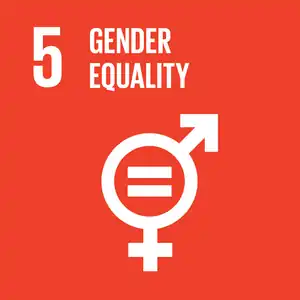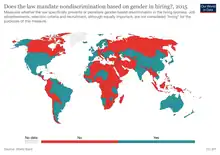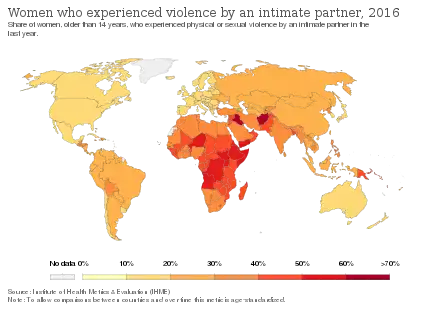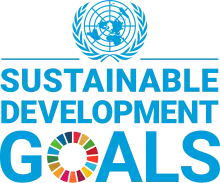Sustainable Development Goal 5
| Sustainable Development Goal 5 | |
|---|---|
 | |
| Mission statement | "Achieve gender equality and empower all women and girls" |
| Commercial? | No |
| Type of project | Sustainable Development Goal |
| Location | Global |
| Owner | Supported by United Nations & Owned by community |
| Founder | United Nations |
| Established | 2015 |
| Website | sdgs |
Sustainable Development Goal 5 (SDG 5 or Global Goal 5) concerns gender equality and is fifth of the 17 Sustainable Development Goals established by the United Nations in 2015. The official wording of SDG 5 is "Achieve gender equality and empower all women and girls".[1] Progress towards targets is measured by indicators. The 17 SDGs recognize that action in one area will affect outcomes in others, and that development must balance social, economic and environmental sustainability. A system thinking approach is the base for global sustainability.[2]
SDG 5 has nine targets and 14 indicators. Six of the targets are "outcome-oriented": ending all forms of discrimination against all women and girls everywhere; ending violence and exploitation of women and girls; eliminating harmful practices such as child, early and forced marriage and female genital mutilation; increasing value of unpaid care and promoting shared domestic responsibilities; ensuring full participation of women in leadership and decision-making; and ensuring access to universal reproductive rights and health. The three "means of achieving" targets are: fostering equal rights to economic resources, property ownership and financial services for women; promoting empowerment of women through technology; and adopting, strengthening policies and enforcing legislation for gender equality.[3]
Through the pledge to "Leave No One Behind", countries have committed to fast-track progress for those furthest behind, first.[4]: 54 SDG 5 aims to grant women and girls equal rights, opportunities to live free without discrimination including workplace discrimination or any violence. This is to achieve gender equality and empower all women and girls.
The COVID-19 pandemic has affected women as they are more vulnerable and have reduced access to treatment.[5] Evidence shows there has been an increase in violence against women during the pandemic.[6]
Background
The Sustainable Development Goals are a collection of 17 global goals set by the United Nations.[1] The broad goals are linked yet each has its own targets to achieve. The SDGs cover a broad range of social and economic development issues. These include poverty, hunger, health, education, climate change, gender equality, water supply, sanitation, energy, urbanization, environment and social justice.[7]
The SDGs replaced the Millennium Development Goals (MDGs).[4] The Outcome Document of the UN Summit on the 2030 Agenda is the document called "Transforming our world: the 2030 Agenda for Sustainable Development". It includes an emphasis on the importance of achieving progress on peaceful and inclusive societies, access to justice and rule of law, and effective, accountable and inclusive institutions.[8]
Providing women and girls with equal access to education, health care, decent work, and representation in political and economic decision-making processes will fuel sustainable economies and benefit societies and humanity at large. There are 9 targets and 14 Indicators for SDG 5.
Gender equality by 2030 requires urgent action to eliminate many root causes of discrimination that curtail women's rights in private and public spheres. Eliminating gender-based violence and rape is a priority, given that it is a human rights violation. The commitment to advancing gender equality has brought improvements in some areas, but the promise of a world in which every woman and girl enjoys full gender equality and all legal, social and economic barriers to their empowerment, including digital empowerment is still wanting.[8]
Providing women and girls with equal access to education, technology, health care, decent work, and representation in political and economic decision-making processes will nurture sustainable economies and benefit societies and humanity at large.[9] Achieving gender equality will require enforceable legislation that promotes empowerment of all women and girls and requires secondary education for all girls.[10] The targets call for an end to gender discrimination and for empowering women and girls through technology.[9] There is a direct relationship between technology advancement and women empowerment.[11]
Targets, indicators and progress
.jpg.webp)
The targets and indicators for SDG 5 are extensive and provide equal opportunity for females (women and girls).[12] Targets cover a broad crosscutting gender issues including ending all forms of discrimination against all females everywhere (Target 5.1), violence and exploitation of females (Target 5.2), eliminate practices such as female genital mutilation and forced marriages (Target 5.3), increase value of unpaid care and promote shared domestic responsibilities (Target 5.4), ensure full participation of women in leadership and decision-making (Target 5.5), ensuring access to universal reproductive rights and health (Target 5.6), fostering equal rights to economic resources, property ownership and financial services for women (Target 5.a), promoting empowerment of women through technology (Target 5.b) and adopting, strengthening policies and enforcing legislation for gender equality (Target 5.c).[13]
By strengthening the commitment towards a more gender equal world, the targets help in making the goals more specific. Indicators represent the metrics by which the world aims to track whether these targets are achieved.
Target 5.1: End discrimination against women and girls
The first target of SDG 5 is Target 5.1: "End all forms of discrimination against all females everywhere."[1]

This target has one indicator. Indicator 5.1.1: Whether or not legal frameworks are in place to promote, enforce and monitor equality and non-discrimination on the basis of sex.[13]
This means the indicator works towards the legal frameworks which can be applied to promote and enforce non-discrimination on the basis of sex across various measures including hiring, equal pay, marital rape and property rights, among others.[12][14]
Discrimination against women (or sexism) can be measured with a range of indicators such as early marriage, gender-based violence and women's property rights.[15]
Child marriage has declined over the past decades yet there is no region that is currently on track to eliminate the practice and reach SDG targets by 2030.[16] If current trends continue, between 2017 and 2030, 150 million girls will be married before they turn 18.[16] Though child marriages are four times higher among the poorest than the wealthiest in the world, most countries need to accelerate progress among both groups in order to reach the SDG Goal 5 target to eliminate child marriage by 2030.[16] Cultural belief of child marriage is the foundation in many cases of child marriage that need to be changed.[17] Child marriage is directly related with maternal mortality and pregnancy related complications.
A record of 143 countries guaranteed equality between men and women in their constitutions as of 2014. However, another 52 had not taken this step. In many nations, gender discrimination is still woven into the fabric of legal systems and social norms.
The custodian agencies for Indicator 5.1.1 are UN Women and World Bank.[18]

Target 5.2: End all violence against and exploitation of women and girls
The full title of Target 5.2 is: "Eliminate all forms of violence against all females in the public and private spheres including trafficking, sexual and other types of exploitation."[1]
This target has two indicators:[13][19]
- Indicator 5.2.1: Proportion of ever-partnered women and girls aged 15 years and older subjected to physical, sexual or psychological violence by a current or former intimate partner in the previous 12 months, by form of violence and by age.
- Indicator 5.2.2: Proportion of women and girls aged 15 years and older subjected to sexual violence by persons other than an intimate partner in the previous 12 months, by age and place of occurrence.
The rate of constant intentional abuse against females is a widespread form of human rights offense worldwide. Globally, around 7% of women have been sexually abused by someone other than an intimate partner. Another concern is that many of the sex abuse cases are unreported and so data are sub optimal in many countries related to sexual violence.[20]
Target 5.3: Eliminate forced marriages and genital mutilation

The full title of Target 5.3 is: "Eliminate all harmful practices, such as child, early and forced marriage and female genital mutilation (FGM)".[1] evidence shows that there is no health benefit in the case of female genital mutilation[21]
Eliminating harmful practices is a way of ensuring that girls are able to live their live full potential lives without any harm. Reducing these risk allows for girls pursue their education, own their bodily autonomy and eventually become productive members of the social, economic and political processes.[22] Educating women has a direct proportional relation with the development of the community.[23]
There are two indicators:[13]
- Indicator 5.3.1: Proportion of women aged 20–24 years who were married or in a union before age 15 and before age 18
- Indicator 5.3.2: Proportion of girls and women aged 15–49 years who have undergone female genital mutilation (FGM) or cutting
In 2019, one in five young women 20 to 24 years of age throughout the world was married in childhood, down from one in four in 2004 and with the highest figure in sub-Saharan Africa, with more than one in three young women.[24]
At least 200 million girls and women have been subjected to female genital mutilation, according to recent data from the 31 countries where the practice is concentrated. The harmful practice is becoming less common, but progress is not fast enough to meet the global target of its elimination by 2030.[25][24]

Target 5.4: Value unpaid care and promote shared domestic responsibilities
The full title of Target 5.4: "Recognise and value unpaid care and domestic work through the provision of public services, infrastructure and social protection policies and the promotion of shared responsibility within the household and the family as nationally appropriate"[1]
This target has one Indicator: Indicator 5.4.1 is the "Proportion of time spent on unpaid domestic and care work, by sex, age and location".[13]
Unpaid care and domestic work includes cooking and cleaning, fetching water and firewood or taking care of children and the elderly. Women carry out at least two and a half times more unpaid household and care work than men. As a result, women have less time to engage in paid labor, work longer hours, combining paid and unpaid labor.[22]
Women's unpaid work subsidizes the cost of care that sustains families, supports economies and often fills in for the lack of social services. Yet, it is rarely recognized as "work".[26] Taking cue from countries like Australia, Italy, Fiji, policies should be put in place to promote equal distribution of paid and unpaid work in households to reduce these gender gaps.[27]
Target 5.5: Ensure full participation in leadership and decision-making

The full title of Target 5.5 is: "Ensure women's full and effective participation and equal opportunities for leadership at all levels of decision-making in political, economic and public life."[1]
Advancing global norms and national practices to further women's leadership in politics and public institutions is important for gender equality.[28]
Indicators are:[13]
- Indicator 5.5.1: Proportion of seats held by women in (a) national parliaments and (b) local government
- Indicator 5.5.2: Proportion of women in managerial positions
As at 1 January 2020, representation by women in single or lower houses of national parliament reached 25 per cent, up slightly from 22 per cent in 2015. Women have better access to decision-making positions at the local level, holding 36 per cent of elected seats in local deliberative bodies, based on data from 133 countries and areas.[24]
In 2019, 28 per cent of managerial positions in the world were occupied by women, a small increase from 25 per cent in 2000, while women represented 39 per cent of the world's workers and half of the world's working-age population.[24]
Target 5.6: Universal access to reproductive rights and health
The full title of Target 5.6 is: "Ensuring universal access to sexual and reproductive health and reproductive rights as agreed in accordance with the Program-me of Action of the International Conference on Population and Development and the Beijing Platform for Action and the outcome documents of their review conferences."[1]

Indicators are:[13]
- Indicator 5.6.1: Proportion of women aged 15–49 years who make their own informed decisions regarding sexual relations, contraceptive use and reproductive health care
- Indicator 5.6.2: Number of countries with laws and regulations that guarantee full and equal access to women and men aged 15 years and older to sexual and reproductive health care, information and education
Based on data from 57 countries for the period 2007–2018, only 55 per cent of married or in-union women 15 to 49 years of age made their own decisions regarding sexual and reproductive health and rights, ranging from less than 40 per cent in Central and Western Africa to nearly 80 per cent in some countries in Europe, South- Eastern Asia and Latin America and the Caribbean.[24]
In 2019, in the 75 countries with data, on average, 73 per cent of the laws and regulations needed to guarantee full and equal access to sexual and reproductive health and rights were in place. The findings are particularly encouraging with regard to HIV: on average, countries achieved 87 per cent of enabling laws and regulations for HIV counseling and test services, 91 per cent for HIV treatment and care services and 96 per cent for HIV confidentiality.[24]
Target 5.a: Equal rights to economic resources, property ownership and financial services
The full title of Target 5.a is: "Undertake reforms to give women equal rights to economic resources, as well as access to ownership and control over land and other forms of property, financial services, inheritance and natural resources, in accordance with national laws."[1]
The two indicators are:[13]
- Indicator 5.a.1: Proportion of total agricultural population with ownership or secure rights over agricultural land, by sex; and (b) share of women among owners or rights-bearers of agricultural land, by type of tenure
- Indicator 5.a.2: Proportion of countries where the legal framework (including customary law) guarantees women's equal rights to land ownership and/or control

Target 5.b: Promote empowerment of women through technology
The full title of Target 5.b is: "Enhance the use of enabling technology, in particular information and communications technology, to promote the empowerment of women."[1]
This target has one indicator: Indicator 5.b.1 is the "Proportion of individuals who own a mobile telephone, by sex".[13]
Technology is an important tool for learning, sharing and engaging that should include more gender specific policies that enhance equality.[22]
Empowering women with mobile telephones has been shown to accelerate social and economic development. However, in the 66 countries with data for the 2016–2018 period, the rate of mobile telephone ownership among men was on average 6.8 percentage points higher than the rate among women.[24]
There are wide gender gaps in internet access and use. Men are 21% more likely to have internet access than women, rising to 52% in the world's least developed countries.[29] The majority of those offline are women in developing countries, reinforcing gender inequalities. Between 2013 and 2019, the gender gap in online use rose from 11% to 17%. In least-developed countries over the same period, the gap rose from 30% to 43%.[30]
Target 5.c: Adopt and strengthen policies and enforceable legislation for gender equality
The full title of Target 5.c is: "Adopt and strengthen sound policies and enforceable legislation for the promotion of gender equality and the empowerment of all women and girls at all levels."[1] : 4
This target has one indicator: Indicator 5.c.1 is the "Proportion of countries with systems to track and make public allocations for gender equality and women's empowerment".[13]
Countries should work towards progressive gender equality policies that recognize how structures can enable progress towards women and girls empowerment.[22]
Custodian agencies
Custodian agencies are responsible for monitoring and reporting of indicators:[31]
- Indicator 5.1.1: United Nations Women (UN Women), World Bank (WB), Organization for Economic Cooperation and Development (OECD)
- Indicator 5.2.1 and 5.2.2: United Nations Children's Emergency Fund (UNICEF), UN Women, United Nations Population Fund (UNFPA), World Health Organisation (WHO), United Nations Office on Drugs and Crime (UNODC)
- Indicator 5.3.1 and 5.3.1: United Nations Children's Emergency Fund (UNICEF)
- Indicator 5.4.2.: UNSD, United Nations Women (UN Women)
- Indicator 5.5.1: IPU, United Nations Women (UN Women)
- Indicator 5.5.2: International Labor Organization (ILO)
- Indicator 5.6.1: and 5.6.2 is: United Nations Population Fund (UNFPA)
- Indicator 5.a.1 and 5.a.2: Food and Agriculture Organization (FAO)
- Informator 5.a.2: Food and Agriculture Organization (FAO)
- Inidicator 5.1: International Telecommunication Union (ITU)
- Inidicator 5.c.2: UN Women, Organization for Economic Cooperation and Development (OECD)
Monitoring and progress
An annual report is prepared by the Secretary-General of the United Nations evaluating the progress towards the Sustainable Development Goals.[32]
The SDGs face challenges if more attention is not given to addressing governance challenges crucial to their implementation. This involves considering how government, business, non-governmental organizations, civil society and researchers will work together.[33] High-level progress reports for all the SDGs are published in the form of reports by the United Nations Secretary General, a recent one is the UN's High Level Political Forum thematic review of SDG 5.[22]
Challenges
Impact of COVID-19 pandemic
The COVID-19 pandemic in 2020 also poses a challenge in achieving gender equality. The impact of COVID-19 on women has been:[34]
- Compounded economic impacts particularly for women who are generally earning less, saving less, and hold insecure jobs or living close to poverty.
- The health of women is adversely impacted through the reallocation of resources and priorities, including sexual and reproductive health services.
- Unpaid care work has increased, with children out-of-school, heightened care needs of older persons and overwhelmed health services.
- Gender-based violence has increased exponentially due to restricted movement and economic strain. The lockdown has increased the cases of women and girls violence with over 30% domestic violence increase.[35]
All of these impacts are made worse in contexts where countries have fragile and non-cohesive structures that are able to protect women and girls. The lack of strong institutional and systemic social cohesion continues to undermine the capacity and services needed to progressively achieve gender equality.

The pandemic has affected national statistical systems as data collection operation is now a major workload for statistical agencies in countries with limited resources thereby pushing gender data way down the priority ladder.[36]
Links with other SDGs
Even though SDG 5 is a stand-alone goal, other SDGs can only be achieved if the needs of women receive the same attention as the needs of men. Issues unique to women and girls include traditional practices such as female genital mutilation. Gender equity experts state that without progress on Goal 5, the other goals and targets cannot be achieved. The link between SDG 5 and the other SDGs has been extensively analysed by UN Women's report on gender equality in the 2030 agenda for sustainable development.[37]
For example, access to decent work and regular income for women directly contributes not only to poverty reduction (SDG 1) but also support better education (SDG 4), zero hunger (SDG 2), good health and wellbeing (SDG 3) outcomes. Eliminating all forms of violence against women and girls (Target 5.2) is not only an essential component of SDG 5 but also critical to ensuring healthy lives and well-being for people of all ages (SDG 3). Women subjected to sexual or physical intimate partner violence are 1.5 times as likely to become infected with HIV (Target 3.3). Environmental degradation (SDG 13) has effects on food production, food safety and economic security of societies that depend on agriculture where women are. Eliminating these and other gender-specific constraints and other forms of discrimination is thus a critical agenda for SDG 5.[22]: 4
Organizations
.jpg.webp)
Several global organizations have vowed to achieve progress towards SDG 5 in various ways. For example:
- UN Women works for the empowerment of women.
- Equality Now advocates for the protection and promotion of the human rights of women and girls.
- Vital Voices works with women leaders in the areas of economic empowerment, women's political participation, and human rights.
- UNDP works to promote women's participation and leadership in all forms of decision-making.[28]
- UNICEF builds partnerships across the global community to accelerate gender equality.
- WHO is working for a world in which no one misses out on health services because of their gender – or for any other reason.
US Based Organizations
In the US there are over thirteen thousand tax-exempt organizations working on issues related to UN SDG 5, according to data filed with the Internal Revenue Service –IRS and aggregated by X4Impact.[38] X4Impact, with the support of the Rockefeller Foundation, Ford Foundation,[39] Hewlett Foundation,[40] and Giving Tech Labs, created a free online interactive tool Gender Equality in the US. This online tool enables users to see gender equality related indicators nationally and by state, as well as relevant information for over thirteen thousand tax-exempt organizations in the US working on issues related to UN SDG 5. The nonprofit data in the tool is updated every 15 days while the indicators are updated annually.
Society and culture
The World Pensions Council (WPC) has insisted on the transformational role gender-diverse boards can play in that regard, predicting that 2018 could be a pivotal year, as "more than ever before, many UK and European Union pension trustees speak enthusiastically about flexing their fiduciary muscles for the UN's Sustainable Development Goals, including SDG 5, and to achieve gender equality and empower all women and girls."[41]
Some have advocated for "listening to girls". The assertion is that the SDGs can deliver transformative change for girls only if girls are consulted. Their priorities and needs must be taken into account. Girls should be viewed not as beneficiaries of change, but as agents of change. Engaging women and girls in the implementation of the SDGs is crucial.[42]
References
- 1 2 3 4 5 6 7 8 9 10 11 United Nations (2017) Resolution adopted by the General Assembly on 6 July 2017, Work of the Statistical Commission pertaining to the 2030 Agenda for Sustainable Development (A/RES/71/313 Archived 23 October 2020 at the Wayback Machine)
- ↑ "A Systems Approach to Global Sustainability". Future Earth. Archived from the original on 28 November 2020. Retrieved 30 September 2020.
- ↑ "Goal 5: Gender Equality - SDG Tracker". Our World in Data. Archived from the original on 26 November 2020. Retrieved 20 August 2020.
- 1 2 Sustainable development goals report 2016. New York: United Nations. 2016. ISBN 978-92-1-101340-5. OCLC 959869696. Archived from the original on 28 November 2020. Retrieved 27 August 2020.
- ↑ "sustainability". Archived (PDF) from the original on 13 November 2020. Retrieved 25 September 2020.
- ↑ Onyango, Monica Adhiambo. "Sexual and gender-based violence during COVID-19: lessons from Ebola". The Conversation. Archived from the original on 25 November 2020. Retrieved 30 September 2020.
- ↑ United Nations (2015) Resolution adopted by the General Assembly on 25 September 2015, Transforming our world: the 2030 Agenda for Sustainable Development (A/RES/70/1 Archived 22 May 2019 at the Wayback Machine)
- 1 2 "Transforming our world: the 2030 Agenda for Sustainable Development – Sustainable Development Knowledge Platform". United Nations. Archived from the original on 12 September 2018. Retrieved 13 August 2020.
- 1 2 "Goal 05. Achieve gender equality and empower all women and girls – Indicators and a Monitoring Framework". indicators.report. indicators.report. Archived from the original on 19 November 2020. Retrieved 5 August 2017.
- ↑ "Sustainable Development Goal 5: Gender equality". UN Women. UN Women. Archived from the original on 26 November 2020. Retrieved 5 August 2017.
- ↑ "Making innovation and technology work for women". UN Women. Archived from the original on 28 November 2020. Retrieved 30 September 2020.
- 1 2 "Goal 5: Gender Equality – SDG Tracker". Our World in Data. Archived from the original on 26 November 2020. Retrieved 20 August 2020.
- 1 2 3 4 5 6 7 8 9 10 11 12 13 14 Ritchie, Roser, Mispy, Ortiz-Ospina (2018) "Measuring progress towards the Sustainable Development Goals." (SDG 5) Archived 26 November 2020 at the Wayback Machine SDG-Tracker.org, website
- ↑ "Child marriage". www.unicef.org. Archived from the original on 19 September 2020. Retrieved 27 August 2020.
- ↑ "Discrimination against women persists around the globe hampering development". UN Women. Archived from the original on 14 August 2020. Retrieved 25 August 2020.
- 1 2 3 "Progress for Every Child in the SDG Era" (PDF). UNICEF. Archived (PDF) from the original on 15 July 2020. Retrieved 2 April 2018.
- ↑ "WHO | Child marriages: 39 000 every day". WHO. Archived from the original on 24 April 2015. Retrieved 30 September 2020.
- ↑ "UNECE" (PDF). UNECE. Archived (PDF) from the original on 1 October 2020. Retrieved 24 September 2020.
- ↑ Sustainable Development Goals (2020). "SDG Indicators Metadata repository".
- ↑ 244. "Sexual Assault Remains Dramatically Underreported | Brennan Center for Justice". www.brennancenter.org. Archived from the original on 20 January 2021. Retrieved 30 September 2020.
{{cite web}}: CS1 maint: numeric names: authors list (link) - ↑ "Female genital mutilation". www.who.int. Archived from the original on 29 January 2021. Retrieved 30 September 2020.
- 1 2 3 4 5 6 High Level Political Forum on Sustainable Development (2017) 2017 HLPF Thematic review of SDG 5: Achieve gender equality and empower all women and girls Archived 31 July 2020 at the Wayback Machine
- ↑ Gillard, Julia; Blanchett, Cate (1 October 2014). "Educate women and their community will prosper. Deny them education and the world will suffer | Julia Gillard and Cate Blanchett". The Guardian. ISSN 0261-3077. Archived from the original on 19 November 2020. Retrieved 30 September 2020.
- 1 2 3 4 5 6 7 United Nations (18 April 2020). "Progress towards the Sustainable Development Goals, Report of the Secretary-General". United Nations. High-level political forum on sustainable development, convened under the auspices of the Economic and Social Council (E/2020/57). Archived from the original on 30 December 2020. Retrieved 27 August 2020.
- ↑ "Female genital mutilation". www.unicef.org. Archived from the original on 30 December 2020. Retrieved 27 August 2020.
- ↑ "Redistribute unpaid work". UN Women. Archived from the original on 5 August 2020. Retrieved 20 August 2020.
- ↑ BMGF (2020) Covid-19 A Global Perspective - 2020 Goalkeepers Report Archived 18 October 2020 at the Wayback Machine Bill & Melinda Gates Foundation, Seattle, USA
- 1 2 "Women's participation in decision-making". UNDP. Archived from the original on 25 September 2020. Retrieved 20 August 2020.
- ↑ "The gender gap in internet access: using a women-centred method". World Wide Web Foundation. 10 March 2020. Archived from the original on 24 September 2020. Retrieved 25 September 2020.
- ↑ ITU, Publications (2019). "Measuring Digital Development, Facts and Figures" (PDF). itu.int. Archived (PDF) from the original on 19 September 2020. Retrieved 25 September 2020.
- ↑ "United Nations (2018) Economic and Social Council, Conference of European Statisticians, Geneva, Custodian Agencies fpr SDG5" (PDF). UNECE. Archived (PDF) from the original on 1 October 2020. Retrieved 25 September 2020.
- ↑ United Nations (2017) Progress towards the Sustainable Development Goals Report of the Secretary-General Archived 3 July 2019 at the Wayback Machine, High-level political forum on sustainable development, convened under the auspices of the Economic and Social Council, 11 May 2017
- ↑ "3 challenges facing the UN's Sustainable Development Goals". World Economic Forum. Archived from the original on 22 September 2020. Retrieved 20 August 2020.
- ↑ United Nations (2020) Policy Brief: The Impact of COVID-19 on Women Archived 27 November 2020 at the Wayback Machine
- ↑ "The sustainable development goals report 2020" (PDF). Archived (PDF) from the original on 30 December 2020. Retrieved 26 September 2020.
- ↑ "From Insights to Action: Gender Equality in the Wake of COVID-19" (PDF). UN Women. 2020. Archived (PDF) from the original on 4 September 2020. Retrieved 25 September 2020.
- ↑ Turning promises into action : gender equality in the 2030 Agenda for Sustainable Development. UN Women. New York, NY. 21 March 2019. ISBN 978-1-63214-108-8. OCLC 1096436801. Archived from the original on 28 November 2020. Retrieved 27 August 2020.
{{cite book}}: CS1 maint: others (link) - ↑ "Press Release: X4Impact, a Market Intelligence Platform for Social Innovation, Announced U.S. Launch During the 2020 Un General Assembly - NextBillion". nextbillion.net. Retrieved 16 November 2021.
- ↑ X4Impact. "Ford Foundation Fuels Tech for the Public Interest with X4Impact". www.prnewswire.com. Retrieved 16 November 2021.
- ↑ "Press Release: Hewlett Foundation Becomes X4Impact Founding Partner to Advance Technology for the Public Interest With Focus on Entrepreneurs Creating Tech for Good Solutions - NextBillion". nextbillion.net. Retrieved 16 November 2021.
- ↑ Firzli, Nicolas (3 April 2018). "Greening, Governance and Growth in the Age of Popular Empowerment". FT Pensions Experts. Financial Times. Retrieved 27 April 2018.
- ↑ Leach, Anna (2 June 2015). "21 ways the SDGs can have the best impact on girls". The Guardian. Archived from the original on 18 June 2018. Retrieved 5 August 2017.
External links
- UN Sustainable Development Knowledge Platform – SDG 5
- “Global Goals” Campaign - SDG 5
- SDG-Track.org - SDG 5
- UN SDG 5 in the US
